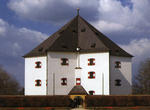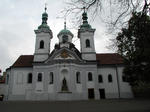
Visitors to Prague, finding the old centre packed with sights, tend to ignore the suburbs. It is true that once you start exploring away from the centre, the language can become more of a problem. However, it is well worth the effort, firstly to escape the crowds of tourists milling around the Castle and the Old Town Square, second to realize that Prague is a living city as well as a picturesque time capsule. Most of the museums and other sights are easily reached by Metro, tram or even on foot. If you are prepared to venture a little west, do not miss the grand Hvezda (star) hunting lodge or the former monastery at Brevnov.
Hvezda renaissance Summer Lodge
Access: trams Nos. 8, 22, Vypich stop; Nos. 1, 18, Petriny stop; bus No. 179 from Nove Butovice station on Metro 'B', bus No. 191 from Andel station on Metro 'B'.
Emperor Ferdinand I. established the New Royal Hunting Park on the western edge of Prague in 1530. His younger son, Archduke Ferdinand of Tyrol, himself designed the Hvezda summer lodge in Mannerist style. The three-storeyed structure of a six-pointed-star ground plan was erected in 1555-1556. The vaults on the ground floor were richly decorated with stucco, regarded as one of the most beautiful examples of the work of Italian Renaissance stuccoworkers in Central Europe. The original fireplaces have been preserved on the first floor, and a large banquet hall with a Renaissance glazed tiled floor on the second. Also part of the complex is the manager's house and the game-keeper's house, or Myslivna. The public have been allowed to stroll in the forested hunting park since 1797.
Brevnov Monastery
Access: trams Nos. 8, 22, Brevnovsky klaster stop
 Prince Boleslav II. and bishop Vojtech (Adalbert) founded Bohemia's first monastery next to the road leading to Bavaria, at the springs of the Brusnice stream, not far from Prague Castle, in 993. From the beginning the monastery enjoyed an exclusive status and the Brevnov Benedictines went as missionaries to Poland and Hungary. The large complex was built in a valley on a regular ground plan surrounding square courtyards. It comprises the church of St. Margaret, the convent and prelature, outbuildings, entrance gate and garden with the Vojteska summer lodge. The present Baroque form of the church and monastery dates from the early 18th century, when it was rebuilt after the design of Christoph and Kilian Ignaz Dientzenhofer. The original Romanesque monastic church was built in 1030-1040, and the crypt in the choir of the present-day church has been preserved from that time. The highly dynamic and illusionist-painted interiors are typical of the High Baroque. The altarpieces are the work of P. Brandl, the sculptures, woodcarvings, ceiling frescoes and other interior decorations are fine examples of the art and handicrafts of that time.
Prince Boleslav II. and bishop Vojtech (Adalbert) founded Bohemia's first monastery next to the road leading to Bavaria, at the springs of the Brusnice stream, not far from Prague Castle, in 993. From the beginning the monastery enjoyed an exclusive status and the Brevnov Benedictines went as missionaries to Poland and Hungary. The large complex was built in a valley on a regular ground plan surrounding square courtyards. It comprises the church of St. Margaret, the convent and prelature, outbuildings, entrance gate and garden with the Vojteska summer lodge. The present Baroque form of the church and monastery dates from the early 18th century, when it was rebuilt after the design of Christoph and Kilian Ignaz Dientzenhofer. The original Romanesque monastic church was built in 1030-1040, and the crypt in the choir of the present-day church has been preserved from that time. The highly dynamic and illusionist-painted interiors are typical of the High Baroque. The altarpieces are the work of P. Brandl, the sculptures, woodcarvings, ceiling frescoes and other interior decorations are fine examples of the art and handicrafts of that time.
When the monastery was returned to the order in the early 1990s, it was reconstructed in time for the 1,000th anniversary of its foundation.

 Guide
Guide 



